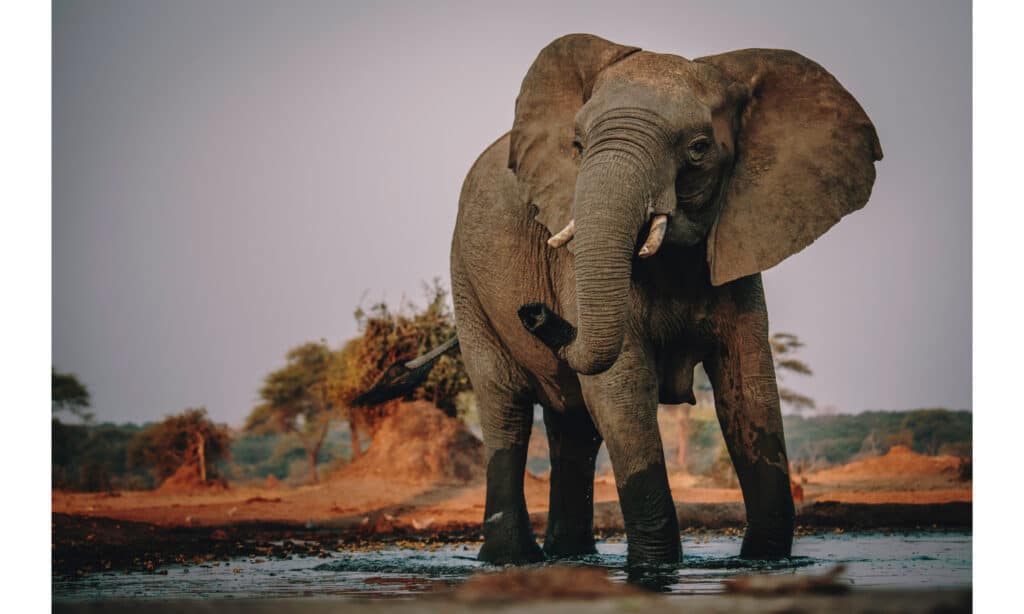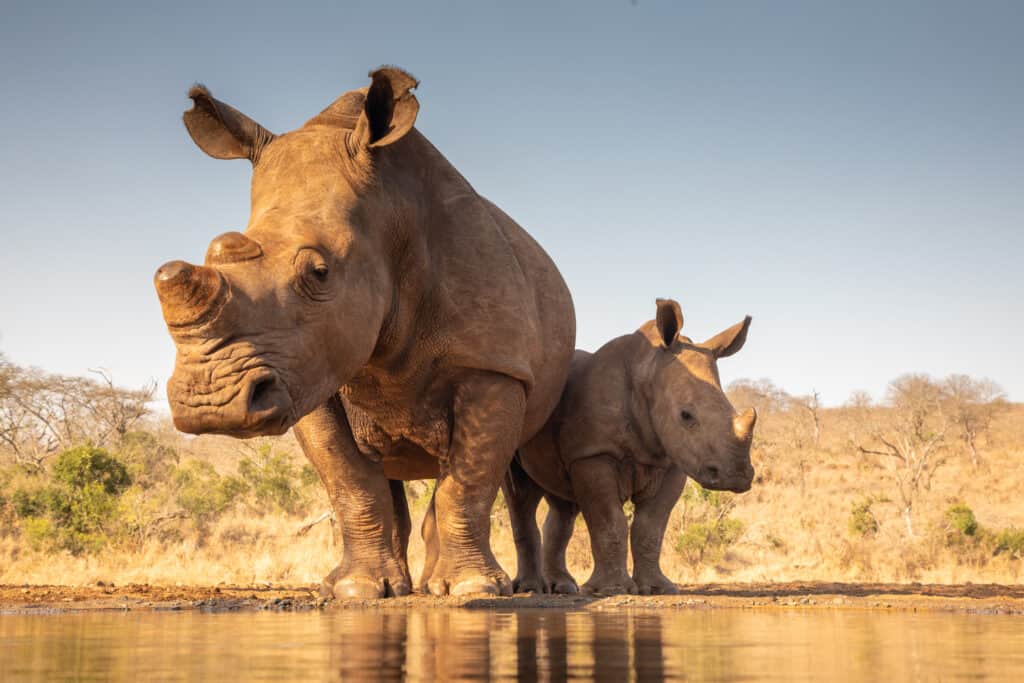The two largest land animals are the elephant and the rhino, with elephants growing to be as much as 15,000lbs and rhinos 7,900lbs.
Elephants are much taller, reaching heights of 10 to 12 feet, while rhinos are nearly half as tall at 4 to 6 feet in height. Standing next to each other you can tell a huge difference.
So, what do these large animals have in common and what makes them different? If they met in the wild who would win the battle? Do they have similar habitats and come into contact with one another? What about in a foot race, who is faster? Are tusks stronger than horns?
Let’s break it all down below and find out more about rhinos and elephants!
Fast Facts About Rhinos
Rhinos are sometimes described as tanks of the jungle; they have massive bodies with shorter legs and thick, tough skin that resembles armor. But, the most defining feature is their large horn protruding from their head. This horn can reach lengths of 5 feet or more!
Five species of rhinos live in Africa and Asia. They used to exist all over these continents, but now they’re only present in a handful of areas because of poaching and habitat loss. The black rhino and white rhino live only in the grasslands in Africa, while the Indian rhino calls the deserts and shrublands home. Sumatran rhinos live in tropical forests in India and Borneo, and only a few Javan rhinos remain and they are kept at the Ujung Kulan National Park in Indonesia to preserve the species.
Fast Facts About Elephants
Elephants are large gray animals with thick legs and long trunks for a nose. On either side of their trunk are long white tusks that can reach 6 feet or more. Their heads have large flap-like ears that can grow as large as 6 feet tall in some African elephants.
There are 3 species of elephants with a few subspecies. There are the largest which are African Bush elephants, then there are African Forest elephants and Asian elephants. Side by side, the African and Asian elephants have distinct differences.
African Elephants have round heads, larger ears, and long white tusks. Asian elephants have dome-shaped heads and smaller ears, and only the males have tusks. They also have tiny hairs all over their backs and molted-colored skin patches. African Bush elephants live in the savannahs in Africa, and the African Forest elephant lives in the tropical forests.
Asian elephants include the subspecies based on where they live including the Indian, Sumatran, Sri Lankan, and Borneo Pygmy elephant.

©iStock.com/fotografie-kuhlmann
What Do They Have in Common?
Rhinos and elephants have some similarities, with the most obvious being they are both large grayish animals with leathery skin. They share similar habitats with some species living in savannah areas and others in tropical forests. Both inhabit Africa and Asia and may come across each other in the wild.
Their diets are similar as well, with both being herbivores (or megaherbivores being animals that weigh more than 2,000lbs and only eat vegetation). Depending on which habitat they live they typically eat grasses, fruit, trees, and leaves.
Both rhinos and elephants are at the top of the food chain and do not have any real predators, however smaller or juvenile rhinos and elephants can be preyed on by lions, leopards, jaguars, and even crocodiles.
One unfortunate commonality that these species have is that they are both poached for horns in the case of rhinos and tusks in the case of elephants.
How Do Tusks and Horns Differ?
The rhino’s horn is intimidating for sure, up to 5 feet long and protruding from the top of its nose. White, black, and Sumatran rhinos all have two horns, one large and one smaller. The Indian and Javan rhinos only have one horn and the one-horned rhinos are the species that are the most endangered.
Rhinos’ horns are made of keratin, which is the same protein that makes up human fingernails and hair. A collection of hair-like material woven together is actually what makes the hard, stiff horn. If a rhino loses a horn, like during a fight with a predator, it can grow back over time. Although this is true, the fact is that poachers frequently shoot the rhinos before removing their horns, killing the animal altogether. The horns are used as a status symbol and are also thought to have medicinal properties in Chinese culture.
Elephant tusks can grow even longer than a rhino’s horn, reaching lengths of 6 feet. The tusks are actually incisor teeth that just keep growing and are connected to the elephant’s skull. Similar to our teeth, they have nerve endings in the tooth making it very painful if an elephant loses a tusk. And, like human teeth, tusks do not grow back.
All African elephants have tusks, whereas only male Asian elephants have tusks. Poachers kill elephants for their ivory tusks, using them for jewelry, carving, piano keys, billiard balls, and as a status symbol. The United States as well as many other countries ban the sale of ivory to help protect the elephant population. According to the World Wildlife Fund, on December 31, 2017, there was a ban on the sale of ivory in China, making this step widely celebrated by conservationists.

©iStock.com/PeterVanDam
Who Lives Longer, Rhinos or Elephants?
As conservationists make progress to help prolong the lives of both species, which one naturally lives longer? Elephants have one of the longest lifespans of all land animals and can live from 55 to 70 years. A rhino’s life span is 40 to 50 years. So, elephants live longer.
Which is Faster, Rhinos or Elephants?
If we cleared the savannah, drew a start and finish line, and had an elephant next to a rhino waiting for the “ready, set, go!” call, who do you think would win? Be ready for the ground to shake for sure!
Elephants’ legs are quite a bit longer than rhinos’ legs, so perhaps elephants would have an advantage, but the fact is that rhinos are faster than elephants.
Rhinos can reach speeds up to 25 to 34 mph! Elephants can actually reach pretty good speeds as well but not as fast as Rhinos. Elephants in a hurry typically go around 10 mph but they can reach speeds of 25 mph.
Who Would Win in a Fight, a Rhino or an Elephant?
We did find out that rhinos and elephants may come across each other in the wild. There are instances where they have tried to fight each other, but most of the time they respect each other’s space and do not confront each other.
Videos of confrontations between the two show some fighting with the tusks and horn, but the elephant’s main goal was to try to knock the rhino over and then be able to crush it, damaging vital organs. The rhino tried to maintain its balance and defend itself with its horn. A strategically placed blow with its horn could significantly injure an elephant. But, the video makes it clear that the sheer size of the elephant would probably overtake most rhinos…unless the rhino was able to flee because, as we just learned, rhinos are faster than elephants.
The photo featured at the top of this post is © iStock.com/Alberto Carrera
Thank you for reading! Have some feedback for us? Contact the AZ Animals editorial team.






